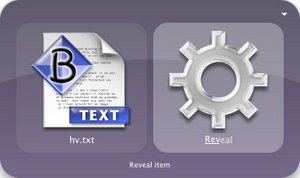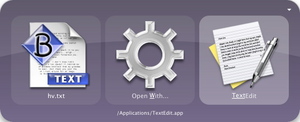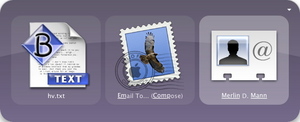Merlin’s weekly podcast with Dan Benjamin. We talk about creativity, independence, and making things you love.
Quicksilver: moving around and training yourself
Merlin Mann | Sep 15 2004
Most people pick up Quicksilver as an application launcher—a virtual valet that shortens the path to your desired application using a couple of intuitive moves. It’s powerful stuff, that, and it’s reason enough to use something like Quicksilver in your workflow. But, the sexy stuff comes when you learn what you can do to stuff with Quicksilver. Let’s start with some baby steps, then look at the advantages of making yourself use Quicksilver as much as possible. [Throat clearing: For economy’s sake, these little mini tutorials assume you’ve installed and configured Quicksilver, installed the appropriate plug-ins (esp. for your mail app in this instance), created a catalog that includes at least your Desktop, Applications, and Address Book, and that you’re using the lovely and popular “bezel” as your interface choice; otherwise, translate accordingly. Kindly RTFM before asking for help. Also, FWIW, this might be easier if you print a PDF of this page out now.] In an earlier post, I had mentioned that it can be valuable to think of Quicksilver’s actions like a spoken sentence, with a subject, a verb, and often an object. You use one thing to do something to, with, or for another thing, right? This is actually almost as literal as it sounds. Let’s try a few examples. Make a text document to do stuff toStart by creating a text file on your Desktop called "hv.txt." Doesn’t matter what’s in it for now. If you don’t have a text file handy (or want to raise your stock in Elizabethan Literature), you can just CTRL- or Right-Click this document and save it to your Desktop (“~/Desktop”). Got it? Cool. Let’s go. “Getting to” a document using Quicksilver
If all worked to plan you should now see “hv.txt” selected in a new Finder window. Neat, huh? You can use this same method to surf to or open any file or folder that’s included in your catalog. Go ahead and try it. Go to your Applications folder, or surf to your Home directory. It’s a lot of fun. “Yeah, but what’s the big whup?” you ask, “I can already do all that in the stupid Finder!” Okay, bigshot, keep your pants on. Let’s try another. Opening a document using Quicksilver
If this worked correctly, your document will have been sent to TextEdit.app, which will open (if it was not open already) and make itself your front window with yout txt document displayed. So, what’s happened so far? We’ve learned that Quicksilver let’s you take stuff on your Mac and do things to it. It lets you navigate through your directories and do the kinds of things that you might normally do with the Finder. So let’s try something just a little more exotic. Emailing a document using Quicksilver
Your pre-selected email app (default is Mail.app) will open, address a message to yourself, and automatically attach your text document. If you’re still feeling full of beans and want to learn more, try doing these same exercises with different documents and notice your available options in that second and third pane; you may be surprised at how many things you can do to a document, a folder, or even a text selection. Mac OSX’s “Services”, for example, are arguably the most under-utilized piece of the whole system. And there they all are, just waiting to do your bidding. So experiment. It’s like a great, unblinking eye!A word on how Quicksilver improves, the more you use it. The thing you’ll start to notice pretty quickly is that Quicksilver learns from you. Every time you type some letters and choose a resulting match, Quicksilver makes a mental note of it. Almost immediately, you should notice that Quicksilver is presenting the choice you’d wanted with fewer and fewer keystrokes. I don’t have a lot of fancy book learning on this sort of thing, but apparently it uses a simple algorithm to learn your preferences and respond accordingly. In addition to being a huge time-saver, this is a great reason to start making yourself use Quicksilver for as many of your activities as possible. It might seem squirrely at first to do things you know perfectly well how to do in the Finder, but remember: Quicksilver’s unblinking eye is watching every precious keystroke so its response can be tuned over time. This has the cumulative effect of making your favorite, most common activities also the fastest things that you do. Give it at a try. Jeez, is that all?Well, the idea today is just to get you comfortable with type-ahead finding, navigating around Quicksilver’s panes, and using the application often enough that it gets trained to your preferences. I know we’re not curing cancer just yet, but it’s important to wrap your head around this 3-pane setup as well as the idea that most anything on your drive—even deeply nested data like address, iTunes playlists, and iPhoto albums—can potentially become the target or destination for a Quicksilver action. So, I really encourage you to play around more with Quicksilver and start trying to make yourself use it as your primary way of getting around your Mac. Read up on the documentation, grab tons of plug-ins, experiment, and come back soon, because this is just getting good. [This has been tested on beta 29 of Quicksilver with many plugins installed and a big-ass catalog. Please email me if you encounter any problems. Thanks.] Printable version of this pageAddendum: Longtime online karass-mate Bill Turner suggests a print-friendly PDF of the page (until your author gets the wherewithal to do a print style sheet). Delighted. http://gladyskravitz.merlinmann.com/43F_QS_Moving_Around.pdf 21 Comments
POSTED IN:
One tip for even faster... by Jay Smith (not verified)
You need to enable the... by bongoman (not verified)
Definitely agree, Merlin. Quicksilvers ability... by Jay Smith (not verified)
fantastic. i've been using launchbar... by denny (not verified)
The "capitalized keys modify action"... by Matt Wilson (not verified)
'Open With' is far quicker... by Jon (not verified)
Just curious, but is there... by Glutnix (not verified)
On Windows you can take... by ush (not verified)
About MerlinBio Merlin Mann is an independent writer, speaker, and broadcaster. He’s best known for being the guy who created the website you’re reading right now. He lives in San Francisco, does lots of public speaking, and helps make cool things like You Look Nice Today, Back to Work, and Kung Fu Grippe. Also? He’s writing this book, he lives with this face, he suffers from this hair, he answers these questions, and he’s had this life. So far. Merlin’s favorite thing he’s written in the past few years is an essay entitled, “Cranking.” |
|
| EXPLORE 43Folders | THE GOOD STUFF |





